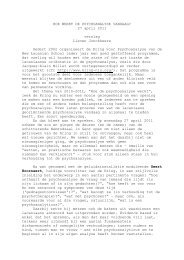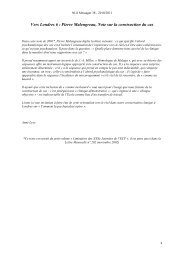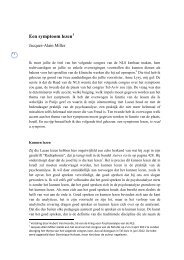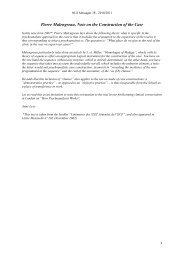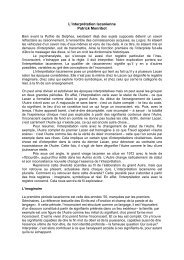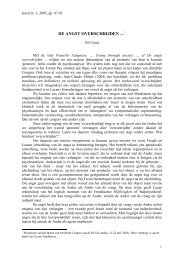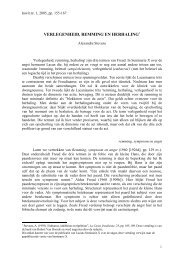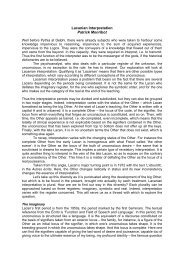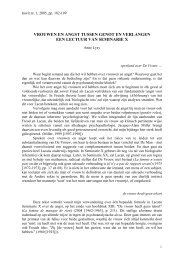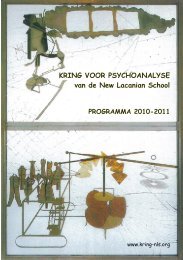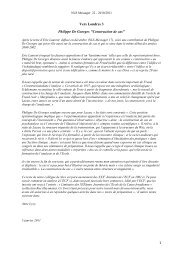Vers Londres 2 Eric Laurent, « Le cas, du - Psychoanalyse Lacan ...
Vers Londres 2 Eric Laurent, « Le cas, du - Psychoanalyse Lacan ...
Vers Londres 2 Eric Laurent, « Le cas, du - Psychoanalyse Lacan ...
You also want an ePaper? Increase the reach of your titles
YUMPU automatically turns print PDFs into web optimized ePapers that Google loves.
NLS Messager 17 - 2010/2011<br />
proceedings” 28 . An intervention was made, the analyst concludes. It is again there, the point of<br />
encounter, that organises the <strong>cas</strong>e. We should note the résumé, the way the <strong>cas</strong>e is condensed,<br />
to come to the crucial point in it.<br />
It is not only in analyses but also in supervision sessions or dialyses, as Gennie <strong>Le</strong>moine says,<br />
that the outside-sense [hors sens] encounter in transference is aimed at. It is undoubtedly linked<br />
to the way in which G. <strong>Le</strong>moine confides in us about how she analysed herself in her supervision<br />
with <strong>Lacan</strong>. She relates the subjective effect pro<strong>du</strong>ced <strong>du</strong>ring one of these supervision sessions.<br />
She was very carefully constructing a clinical picture without feeling that she was there. “I was<br />
reflecting my analytic relation like a mirror, a mirror offered to <strong>Lacan</strong>'s gaze for approval. So<br />
there were only mirrors left. It could have gone on. *…+ This picture that I was painting was<br />
therefore organised on a sort of screen *…+ I was hoping for the thunderbolt that would free me<br />
from it. *…+<br />
“-- You must begin to see...”<br />
The sounding of the <strong>Lacan</strong>ian gong was enough to break the mirror. *…+ The cut had broken the<br />
mirror” 29 . Supervision enabled her to break this relation of images. The first example of such an<br />
effect in supervision bore the name without-limit (sans-limite). “The analyst tells me that he<br />
hears the following words recur insistently: without limits. ‘My analysand does not know any<br />
limits’, he says, by way of conclusion *…+ A memory of a dream that this same analyst had told<br />
me then comes back to me, a dream he had not otherwise paid much attention to. Here is the<br />
dream: the analysand finds himself at home, in his own house, with his analyst. They speak for a<br />
long time (my emphasis). Each person in this house has their own bedroom (how about that!).<br />
They speak, that's all. There it is, the without-limit: it is an endless conversation without sexual<br />
resolution, with his analyst finally at his mercy. It is the desire of the analysand for his analyst<br />
that is without limits *…+”.<br />
What is essential, the analyst concludes, is to make desire emerge: “Whose desire? The question<br />
is problematic” 30 .<br />
The analyst makes this encounter with desire into the decisive support of the subject. “The<br />
intervention thus makes a cut and a subjective effect is grasped in it.” 31 Or again: “The<br />
experience has a radical function, there is nothing before; and there is only one sort of<br />
experience and it is the encounter with the Other. It is a traumatic experience that repeats the<br />
traumatism of birth, of the child thrown, expelled into the human world, in which he is a<br />
stranger” 32 . The experience of the encounter has, in this way, the place of a “Name-of-the-<br />
Father” 33 .<br />
In order to enter into the time of the Other, one needs an experience of this order. The <strong>cas</strong>e is<br />
organised around it. One summarises, one focuses, and one goes for the target. It is also an<br />
28<br />
29<br />
30<br />
31<br />
32<br />
33<br />
Ibid., p. 209.<br />
Ibid., p. 196.<br />
Ibid., p. 193.<br />
Ibid., p. 189.<br />
Ibid., p. 231.<br />
Ibid., p. 186.<br />
12



